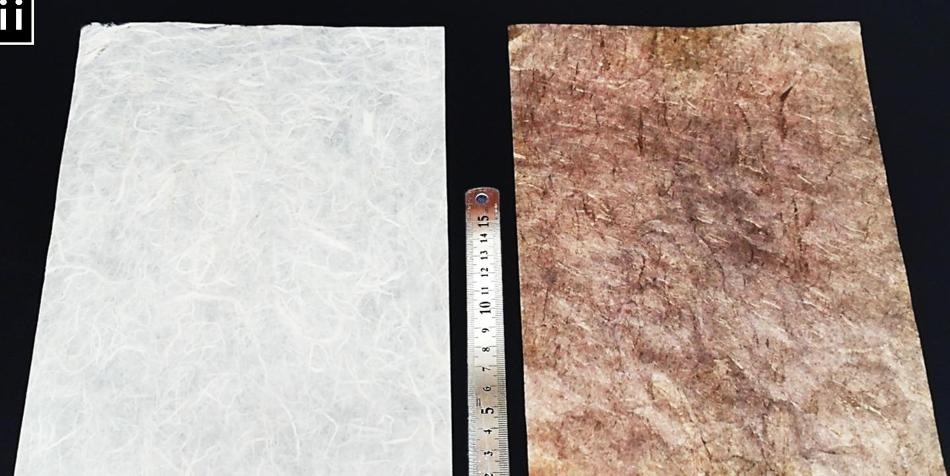Oct 6 2017
Researchers from the U.S. and Korea used a simple layer-by-layer coating technique in order to develop a paper-based flexible supercapacitor capable of being used to help power wearable devices.
The device uses metallic nanoparticles for coating cellulose fibers in the paper, developing supercapacitor electrodes with high energy and power densities - and the finest performance until now in a textile-based supercapacitor.
 Images show the difference between paper prior to metallization (left) and the paper coated with conductive nanoparticles. CREDIT Ko et al., published in Nature Communications
Images show the difference between paper prior to metallization (left) and the paper coated with conductive nanoparticles. CREDIT Ko et al., published in Nature Communications
The technique implants conductive and charge storage materials in the paper in order to develop large surface areas that act as current collectors and nanoparticle reservoirs for the electrodes. Testing demonstrates that without affecting conductivity the devices fabricated with the technique can be folded thousands of times.
This type of flexible energy storage device could provide unique opportunities for connectivity among wearable and internet of things devices. We could support an evolution of the most advanced portable electronics. We also have an opportunity to combine this supercapacitor with energy-harvesting devices that could power biomedical sensors, consumer and military electronics, and similar applications.
Seung Woo Lee, Assistant Professor, Woodruff School of Mechanical Engineering, Georgia Institute of Technology
The research, performed with collaborators at Korea University, received support from the National Research Foundation of Korea and has been published in the September 14th edition of the journal Nature Communications.
Generally, energy storage devices are judged on three properties: their power density, cycling stability and energy density. Supercapacitors frequently have high power density, but low energy density - the amount of energy capable of being stored - compared to batteries, which frequently have the opposite attributes. Lee and collaborator Jinhan Cho from the Department of Chemical and Biological Engineering at Korea University, while developing their new technique, set out to increase energy density of the supercapacitors while maintaining their high power output.
The Researchers started by dipping paper samples into a beaker of solution made up of an amine surfactant material designed in order to bind the gold nanoparticles to the paper. This was followed by dipping the paper into a solution comprising of gold nanoparticles. Since the fibers are porous, the nanoparticles and surfactants enter the fibers and become firmly attached, producing a conformal coating on each fiber.
The Researchers repeated the dipping steps and produced a conductive paper on which they integrated alternating layers of metal oxide energy storage materials such as manganese oxide. The ligand-mediated layer-by-layer approach helped in minimizing the contact resistance between neighboring metal oxide and/or metal nanonparticles. Using the simple process perfomed at room temperatures, the layers can be constricted in order to provide the preferred electrical properties.
It's basically a very simple process. The layer-by-layer process, which we did in alternating beakers, provides a good conformal coating on the cellulose fibers. We can fold the resulting metallized paper and otherwise flex it without damage to the conductivity.
Seung Woo Lee, Assistant Professor, Woodruff School of Mechanical Engineering, Georgia Institute of Technology
Though the research involved tiny samples of paper, the solution-based technique could probably be scaled up using a spray-on technique or bigger tanks. "There should be no limitation on the size of the samples that we could produce," Lee said. "We just need to establish the optimal layer thickness that provides good conductivity while minimizing the use of the nanoparticles to optimize the tradeoff between cost and performance."
The Researchers proved that their self-assembly technique enhances several aspects of the paper supercapacitor, including its areal performance, a vital factor for measuring flexible energy-storage electrodes. The maximum power and energy density of the metallic paper-based supercapacitors are projected to be 15.1mWcm?2 and 267.3 μWh cm?2, respectively, considerably outperforming standard paper or textile supercapacitors.
Steps in the future will include testing the technique on flexible fabrics, and producing flexible batteries capable of working with the supercapacitors. The Researchers made use of gold nanoparticles as they are easy to work with, however, they plan to test less expensive metals such as copper and silver in order to reduce the cost.
Lee developed the layer-by-layer self-assembly process for energy storage using a wide range of materials during his Ph.D. work. With his Korean collaborators, Lee discovered a new opportunity to apply that to wearable and flexible devices with nanoparticles.
"We have nanoscale control over the coating applied to the paper," he added. "If we increase the number of layers, the performance continues to increase. And it's all based on ordinary paper."